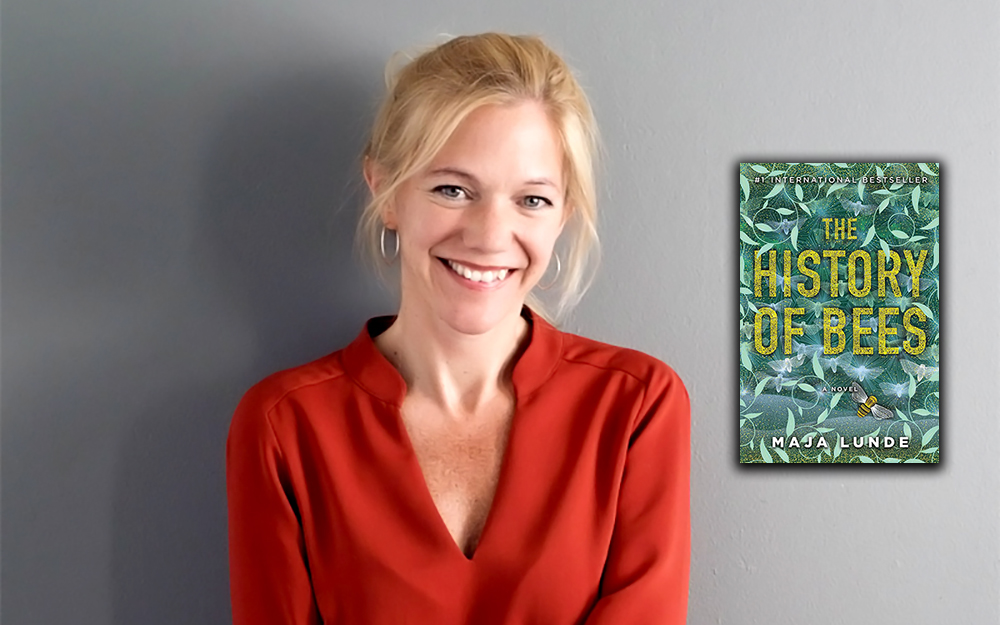
By Heidi Simmons
—–
The History of Bees
by Maja Lunde Fiction
—–
In case you haven’t heard, biodiversity is the key to a healthy planet. Genes, species and ecosystems are connected in symbiotic ways to keep life on earth sustainable. In Maja Lunde’s The History of Bees (Touchstone, 340 pages), the fundamental nature of life is at risk.
Author Lunde tells her story in three separate first-person narratives.
It begins in China 2098 with Tao, who works as a pollinator. Everyday she climbs the trees in orchards with a fine brush to delicately spread pollen onto the blossoms. She and her “group” begin at dawn and end at dusk. It is a tedious and tiring job that has been assigned to her by the “Committee.”
Tao, her husband, and three-year-old son live in a post-apocalyptic world where food shortages have decimated human populations as well as other species. Countries have collapsed across the globe. In Tao’s life, bee colonies no longer exist and a bee is rarely seen.
William is a biologist who lives in 1852 England. As a young man, he dreamed of become a well-respected scientist. But, his desire to contribute something of great importance was sidetracked when he married, had five children and opened a seed shop to support his family.
After being deeply depressed and his business in ruins, William finally comes back to life when his daughter reengages him in the family bee colony. In hopes to restore his reputation and make history, he designs a better beehive, which will allow scientists to more easily study the queen and her colony. William’s new hive design also improves honey and wax collection.
George lives in the United States circa 2007. He is a third-generation bee farmer, who keeps hundreds of hives for the harvest of honey. George hopes that his son, a college student, will take over the beekeeping, even though his interests lie elsewhere.
Honey is no longer profitable. Global competition has forced the price and quality down, and the best way to make money with bees is through the pollination of crops. George knows that with a decline in bees, farms across the US need help and will pay beekeepers well to bring in hives for pollination. Hopefully insuring a successful crop. Without bees, there’s no harvest, no money, and worse, no food!
Central to all three characters is the bee.
After Tao’s son is rushed to a hospital with a medical emergency, the government refuses to let her see him. In the bleakness of this future world, Tao, tries to find her son and solve the mystery of what happened to him.
William discovers that his research and modern beehive design already exist. He has unknowingly duplicated what someone else has already invented. A set back from which he will never recover. He orders his daughter to destroy the beehive blueprints — evidence of his humiliation.
For George, after his bees successfully pollinate a blueberry farm, he is hopeful there is a future his family and bees. But, when he returns home, his bees suffer and die from Colony Collapse Disorder – a mystery yet to be solved.
Tao, William and George all end up being tied together in this story of bees and humans. Some of the connections were obvious, while others came as a nice surprise.
“The History of Bees” actually contains a history of bees. The author tells the story of bees and the necessary role they play in sustaining our planet and the earth’s biodiversity as the three characters live out the challenges of their daily lives.
For me, a fictional narrative is the best ways to learn about a subject. I liked getting to know all about bees through the eyes of the characters and hearing the mythology, science and facts pertaining to apiology.
Bees are fascinating. It is a matriarchal society run by a queen where males have only one purpose, insemination. All bees out pollinating are females. Bees work hard and live in a community to serve a greater good. Bees communicate with each other in a dance code, humans have yet been able to fully crack. They are amazing creatures!
The importance of bees to our way of life on this planet is imperative. Author Lunde makes her point in the disturbing future world where bees no longer exist.
Just like bees, Tao, William and George’s off-spring impact the future by what they contribute during their lifetime.
Intentional or not, “The History of Bees” has a message that is more than just being aware of the dangers in Colony Collapse Disorder. It is also a generational revelation that our actions today –- good or bad – can insure or destroy the future.
Lunde’s story reveals a beautiful and necessary symbiosis between humans and nature. It’s clear that through nurturing these vital relationships we can survive a threatened future.











































